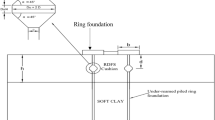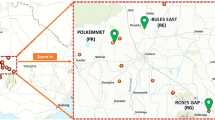Abstract
Sand and soil are comprised of large amounts of discrete particles, which may lead to a transition between solid and fluid-like states in large deformation problems. How to deal with the complex transitions between these states in granular media is the key to explaining the run-out of a landslide. The Shenzhen (China) landfill landslide exemplifies a type of large deformation demonstrating this transition between solid and fluid-like states. The soil in the landfill was mainly composed of completely decomposed granite (CDG). The landslide's run-out traveled in fluid-like fashion several hundred meters and caused casualties. In this paper, we use the material point method (MPM) based on the softening model and contact algorithm to analyze the run-out of the Shenzhen landfill landslide. MPM offers substantial advantages in numerical simulations of problems involving extra-large deformations. The latest research of landslide simulations is reviewed, and the fundamental principles of MPM are introduced in the first part of the paper. Then, the post-failure behavior of the large slope in the Shenzhen landfill is simulated with the generalized interpolation material point (GIMP) method with a softening model and a contact algorithm, respectively. The trend of the velocities and displacements of material points are calculated. Topographies of the post-failure landslide using different parameters are analyzed.

















Similar content being viewed by others
References
Andersen S, Andersen L (2010) Modelling of landslides with the material-point method. Comput Geosci 14(1):137–147
Bardenhagen SG, Brackbill JU, Sulsky D (2000) The material-point method for granular materials. Comput Methods Appl Mech Eng 187(3):529–541
Bardenhagen SG, Guilkey JE, Roessig KM, Brackbill JU, Witzel WM, Foster JC (2001) An improved contact algorithm for the material point method and application to stress propagation in granular material. Comput Model Eng Sci 2(4):509–522
Bardenhagen SG, Kober EM (2004) The generalized interpolation material point method. Comput Model Eng Sci 5(6):477–496
Bardenhagen SG (2002) Energy conservation error in the material point method for solid mechanics. J Comput Phys 180(1):383–403
Beuth L, Benz T, Vermeer PA, Więckowski Z (2008) Large deformation analysis using a quasi-static material point method. J Theor Appl Mech 38(1-2):45–60
Beuth L, Więckowski Z, Vermeer PA (2011) Solution of quasi-static large-strain problems by the material point method. Int J Numer Anal Methods Geomech 35(13):1451–1465
Bui HH, Fukagawa R, Sako K, Ohno S (2008) Lagrangian meshfree particles method (SPH) for large deformation and failure flows of geomaterial using elastic–plastic soil constitutive model. Int J Numer Anal Methods Geomech 32(12):1537–1570
Bro AD, Stewart JP, Pradel D (2013) Estimating undrained strength of clays from direct shear testing at fast displacement rates. Geo-Congress 2013:106–119
Coetzee CJ, Vermeer PA, Basson AH (2005) The modelling of anchors using the material point method. Int J Numer Anal Methods Geomech 29(9):879–895
Hatzor YH, Arzi AA, Zaslavsky Y, Shapira A (2004) Dynamic stability analysis of jointed rock slopes using the DDA method: King Herod's Palace, Masada, Israel. Int J Rock Mech Min Sci 41(5):813–832
Huang Y, Zhang W, Xu Q, Xie P, Hao L (2012) Run-out analysis of flow-like landslides triggered by the Ms 8.0 2008 Wenchuan earthquake using smoothed particle hydrodynamics. Landslides 9(2):275–283
Hungr O (1995) A model for the runout analysis of rapid flow slides, debris flows, and avalanches. Can Geotech J 32(4):610–623
Hutter K, Koch T, Pluüss C, Savage SB (1995) The dynamics of avalanches of granular materials from initiation to runout. Part II. Experiments. Acta Mech 109(1-4):127–165
Jiang YJ, Towhata I (2013) Experimental study of dry granular flow and impact behavior against a rigid retaining wall. Rock Mech Rock Eng 46(4):713–729
Li X, He S, Luo Y, Wu Y (2012) Simulation of the sliding process of Donghekou landslide triggered by the Wenchuan earthquake using a distinct element method. Environ Earth Sci 65(4):1049–1054
Lin ML, Wang KL (2006) Seismic slope behavior in a large-scale shaking table model test. Eng Geol 86(2):118–133
Llano-Serna MA, Farias MM, Pedroso DM (2016) An assessment of the material point method for modelling large scale run-out processes in landslides[J]. Landslides 13(5):1057–1066
Lupini JF, Skinner AE, Vaughan PR (1981) The drained residual strength of cohesive soils. Geotechnique 31(2):181–213
Mast CM, Arduino P, Miller GR, Mackenzie-Helnwein P (2014) Avalanche and landslide simulation using the material point method: flow dynamics and force interaction with structures. Comput Geosci 18(5):817–830
Ma S, Zhang X, Qiu XM (2009) Comparison study of MPM and SPH in modeling hypervelocity impact problems. Int J Impact Eng 36(2):272–282
Manzella I, Labiouse V (2013) Empirical and analytical analyses of laboratory granular flows to investigate rock avalanche propagation. Landslides 10(1):23–36
McDougall S, Hungr O (2004) A model for the analysis of rapid landslide motion across three-dimensional terrain. Can Geotech J 41(6):1084–1097
Merry SM, Kavazanjian E Jr, Fritz WU (2005) Reconnaissance of the July 10, 2000, Payatas landfill failure. J Perform Constr Facil 19(2):100–107
Metzger DR (2003) Adaptive damping for dynamic relaxation problems with non-monotonic spectral response. Int J Numer Methods Eng 56(1):57–80
Nairn JA (2003) Material point method calculations with explicit cracks. Comput Model Eng Sci 4(6):649–664
Nicot F, Darve F (2011) Diffuse and localized failure modes: two competing mechanisms. Int J Numer Anal Methods Geomech 35(5):586–601
Oakley DR, Knight NF (1995) Adaptive dynamic relaxation algorithm for non-linear hyperelastic structures Part I. Formulation. Comput Methods Appl Mech Eng 126(1):67–89
Pastor M, Manzanal D, Merodo JF, Mira P, Blanc T, Drempetic V et al (2010) From solids to fluidized soils: diffuse failure mechanisms in geostructures with applications to fast catastrophic landslides. Granul Matter 12(3):211–228
Pastor, M., Blanc, T., Haddad, B., Petrone, S., Morles, M. S., Drempetic, V., ... & Cuomo, S. (2014). Application of a SPH depth-integrated model to landslide run-out analysis. Landslides 11(5):793–812
Sassa K, Nagai O, Solidum R, Yamazaki Y, Ohta H (2010) An integrated model simulating the initiation and motion of earthquake and rain induced rapid landslides and its application to the 2006 Leyte landslide. Landslides 7(3):219–236
Stark TD, Eid HT, Evans WD, Sherry PE (2000) Municipal solid waste slope failure. II: Stability analyses. J Geotech Geoenviron 126(5):408–419
State Administration of Work Safety. (2016). The investigation report of “12•20” especially major accident of landfill landslide of Guangdong Shenzhen Guangming new district. http://www.chinasafety.gov.cn/newpage/newfiles/20160715szsg.pdf 15th, July, 2016.
Sulsky D, Chen Z, Schreyer HL (1994) A particle method for history-dependent materials. Comput Methods Appl Mech Eng 118(1):179–196
Sulsky D, Zhou SJ, Schreyer HL (1995) Application of a particle-in-cell method to solid mechanics. Comput Phys Commun 87(1):236–252
Tohari A, Nishigaki M, Komatsu M (2007) Laboratory rainfall-induced slope failure with moisture content measurement. J Geotech Geoenviron 133(5):575–587
Valentino, R., Barla, G., & Montrasio, L. (2008). Experimental analysis and micromechanical modelling of dry granular flow and impacts in laboratory flume tests. Rock Mech Rock Eng 41(1):153–177.
Wang B, Vardon PJ, Hicks MA, Chen Z (2016) Development of an implicit material point method for geotechnical applications. Comput Geotech 71:159–167
Wartman J, Seed RB, Bray JD (2005) Shaking table modeling of seismically induced deformations in slopes. J Geotech Geoenviron 131(5):610–622
Więckowski Z (2004) The material point method in large strain engineering problems. Comput Methods Appl Mech Eng 193(39):4417–4438
Xu Q, Peng D, Li W, Dong X, Tang M, Hu W, Tang M, Liu F (2016) The 20 December 2015,catastrophic construction waste landslide at Hongao dumpsite, Guangming New District, Shenzhen, China. In: Natural Hazards and Earth System Sciences Discussion. https://doi.org/10.5194/nhess-2016-196
Yin Y, Li B, Wang W, Zhan L, Xue Q, Gao Y, Li A (2016) Mechanism of the December 2015 catastrophic landslide at the Shenzhen landfill and controlling geotechnical risks of urbanization. Engineering 2(2):230–249
Zhang X, Chen Z, Liu Y (2016) The Material Point Method - A Continuum-Based Particle Method for Extreme Loading Cases. Cambridge, Massachusetts. Academic Press
Acknowledgments
This study is financially supported by the Natural Science Foundation of Jiangsu Province (grant No. BK20160366) and Science & Technology Program of Suzhou (grant No. SYG201613).
Author information
Authors and Affiliations
Corresponding authors
Rights and permissions
About this article
Cite this article
Shi, B., Zhang, Y. & Zhang, W. Run-out of the 2015 Shenzhen landslide using the material point method with the softening model. Bull Eng Geol Environ 78, 1225–1236 (2019). https://doi.org/10.1007/s10064-017-1167-4
Received:
Accepted:
Published:
Issue Date:
DOI: https://doi.org/10.1007/s10064-017-1167-4




